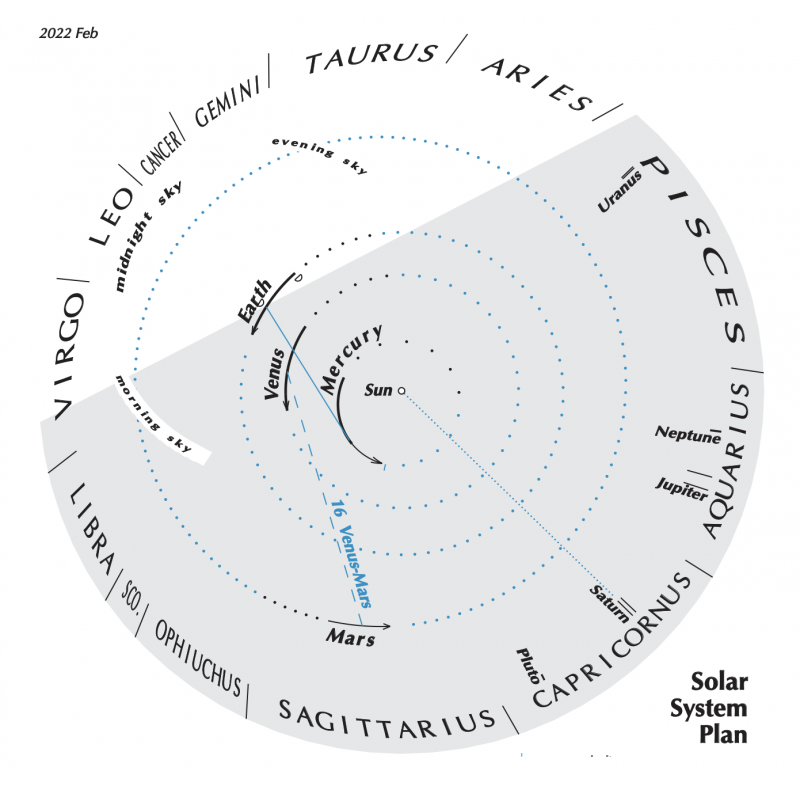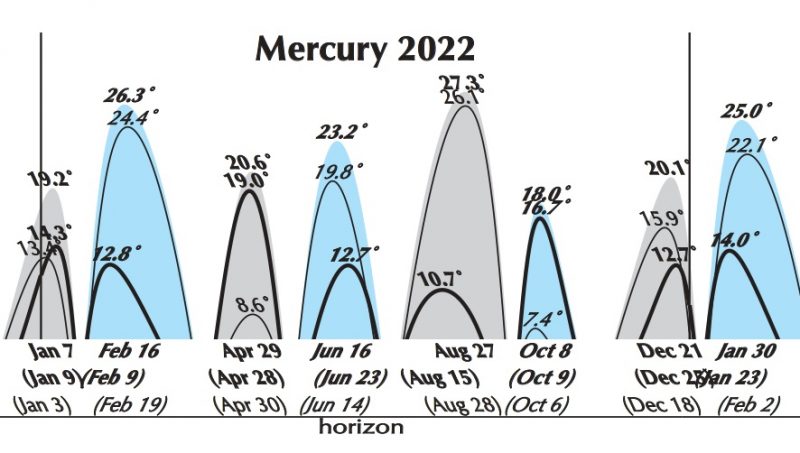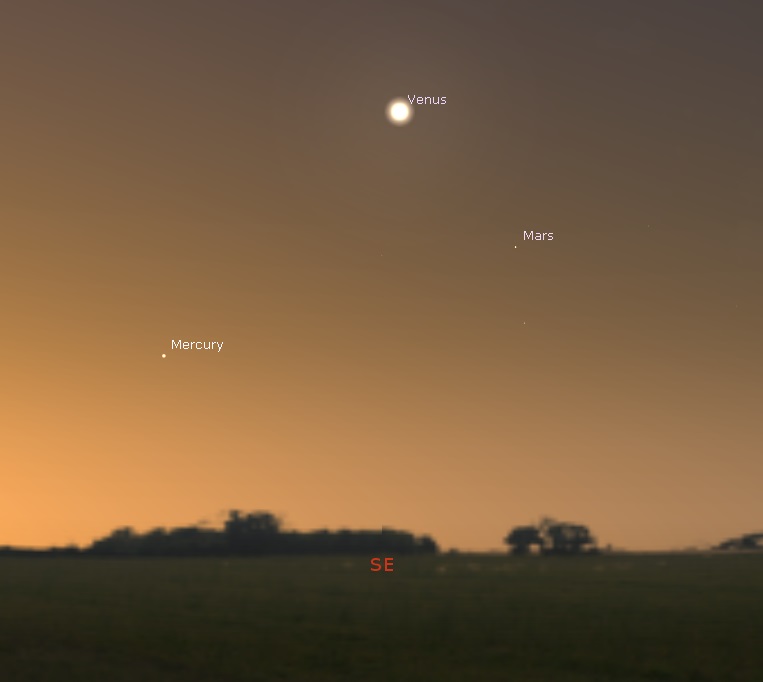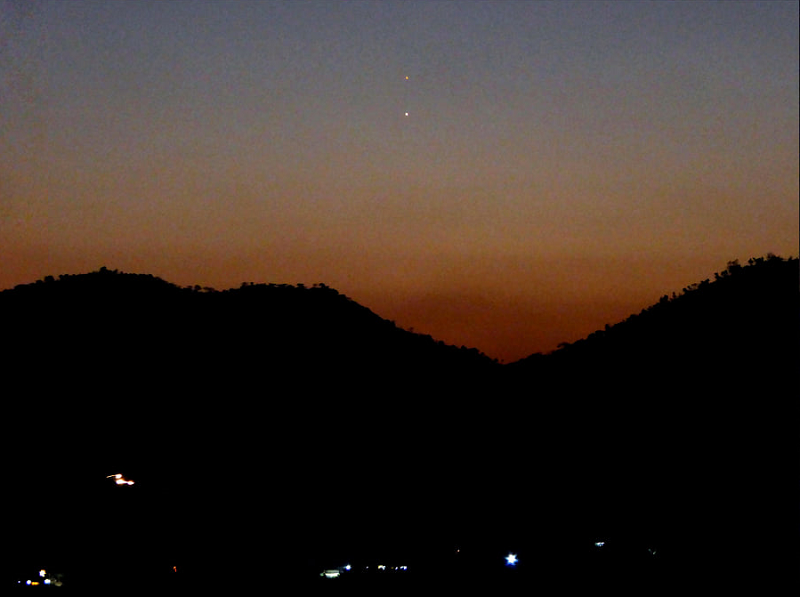
Mercury before sunrise
Of the five planets you can see with the unaided eye, Mercury is the most elusive. Mercury is bright. At its brightest, it outshines most stars in the sky. But, as the innermost planet, Mercury never strays far from the sun in our sky. It’s always seen near sunrise or sunset, and then … not for long. About six times a year, Mercury swings out to one side of the sun as seen from Earth. When it’s farthest from the sun on our sky’s dome, astronomers say Mercury is at greatest elongation. At Mercury’s greatest elongation this month, it’ll be farthest from the sun in the east before sunrise. That’ll happen on February 16, 2022. But don’t wait until then to look for Mercury. It’s in view now, below the much-brighter planet Venus and red Mars, near the sunrise point shortly before sunup.
So brilliant Venus and reddish Mars will be above your dawn horizon before Mercury makes its brief appearance. These worlds – Mercury, Venus, Mars plus Earth beneath your feet – are the four small rocky planets that orbit closest to the sun in our solar system. Check them out!

The 2022 lunar calendars are still available. Order yours before they’re gone!
A comparison of elongations
Elongations are also better or worse depending on the time of year they occur. And so the Northern and Southern Hemispheres trade places in being able to see Mercury best. The morning apparition of Mercury in October 2021 was best for the Northern Hemisphere. This time, the Southern Hemisphere has the best view.
In the autumn for either hemisphere, the ecliptic makes a narrow angle to the horizon in the evening. But it makes a steep slant, nearly perpendicular, in the morning. So – in autumn from either hemisphere – morning elongations of Mercury are best. Then Mercury appears higher above the horizon and farther from the glow of the sun. Evening elongations in autumn are harder to see.
In the spring for either hemisphere, the situation reverses. The ecliptic and horizon meet at a sharper angle on spring evenings and a narrower angle on spring mornings. So – in springtime for either hemisphere – evening elongations of Mercury are best. Morning elongations are harder to see.
Here’s another factor in how well we all can see Mercury, no matter where we are on Earth. Not all greatest elongations are created equal. Some are greater than others. The farthest from the sun that Mercury can ever appear on the sky’s dome is about 28 degrees. The least distance is around 18 degrees. At the February 16, 2022, greatest elongation, Mercury will be 26 degrees from the sun on our sky’s dome.
The chart below says it best:

Mercury in February 2022
At this February 2022 elongation of Mercury, the planet shines at around magnitude 0.1. Mercury will get a little bit brighter later in the month as it drops closer to the sun. But, of course, when it’s closer to the sun it will be harder to see in brighter twilight, as sunrise approaches.
Mercury’s greatest western elongation is on February 16 at 21 UTC. But the mornings before and after this are all great times to spot Mercury. In fact, Mercury’s highest altitude in the morning sky is on February 9.

The planet is passing from the constellation Sagittarius into Capricornus in February. Venus and Mars will remain up in Sagittarius, but Saturn is lurking down in Capricornus. Mercury heads down to meet it, but Northern Hemisphere observers probably won’t get to see the pair. The moon will be near the duo on February 28. And in early March, Mercury and Saturn pull alongside each other before Mercury sinks even lower. Those in the Southern Hemisphere, however, get to witness these events.
Telescopic view of Mercury in February 2022
Those with telescopes will get to view Mercury at about 60% illumination, showing a gibbous phase like a waxing gibbous moon. Mercury’s phase will grow larger as the month progresses. But again, toward the end of the month it’s drowned out from the light of the rising sun.
On February 16, Mercury will be 6.9 arcseconds in size. Because Mercury is moving farther away from us in its orbit, the size will decrease over the following days.
Mercury events in 2022
February 16: Mercury at greatest western elongation
April 29: Mercury at greatest eastern elongation
June 16: Mercury at greatest western elongation
August 27: Mercury at greatest eastern elongation
October 8: Mercury at greatest western elongation
December 21: Mercury at greatest eastern elongation



Bottom line: Watch for Mercury in a triangle with two other planets – brilliant Venus and red Mars – in the east before sunup. Mercury reaches greatest western elongation on February 16, 2022.
The post Mercury before sunrise: Start watching around February 8 first appeared on EarthSky.
0 Commentaires